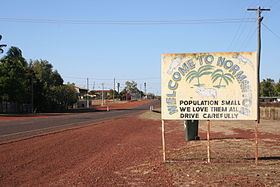Population 1,468 (2011 census) Postcode(s) 4890 Local time Friday 7:59 PM | Established 1867 Postal code 4890 | |
 | ||
Location 2,088 km (1,297 mi) NW of Brisbane689 km (428 mi) W of Cairns227 km (141 mi) E of Burketown157 km (98 mi) W of Croydon Weather 28°C, Wind SE at 10 km/h, 39% Humidity | ||
Normanton is a small cattle town and locality in the Shire of Carpentaria in Queensland, Australia. In the 2011 census, Normanton had a population of 1,468 people of whom 696 were Indigenous Australians.
Contents
- Map of Normanton QLD 4890 Australia
- Geography
- History
- Heritage listings
- Industry
- Facilities
- Transport
- Climate
- References
Map of Normanton QLD 4890, Australia
The town is one terminus of the isolated Normanton to Croydon railway line, which was built during gold rush days in the 1890s. The Gulflander motor train operates once a week.
Normanton is the administrative centre of Shire of Carpentaria. Among Normanton's most notable features is a statue of an 8.64 m long saltwater crocodile named Krys, the largest ever taken, which was shot by Krystina Pawlowska in July 1957 in the Norman River. Barramundi and Threadfin Salmon may also be caught in the river. The Big Barramundi, which is 6 m long is also located in the town.
Geography
Normanton is in the Gulf Country region of northwest Queensland, just south of the Gulf of Carpentaria, on the Norman River.
History
The site for the town was selected because Burketown was abandoned owing to fever and flooding. Settlers moved into the town in 1867. Normanton attracted people from a variety of cultures, including Chinese drawn to the gold fields. The population reached 1,251 by 1891. The gold boom was short-lived. By 1947 the town's population had declined to 234. Norman River Post Office opened on 13 June 1868 and was renamed Normanton by 1872.
In the early years there was a large Aboriginal population as well. Some Aboriginal people were moved to Mornington Island and Doomadgee in the early 20th century.
The town contains the longest intact and operating Burns Philp store in Queensland. The general mercantile store and agency office was opened in 1884.
In 2006 census, the town's population was 1,100, 60 per cent of whom were Indigenous Australians.
Heritage listings
Normanton has a number of heritage-listed sites, including:
Industry
Like other Gulf communities the prawning industry makes an important economic contribution to the town. Tourism has recently become an important part of the economy of Normanton, with Gulflander a significant draw-card.
Facilities
Normanton has a sports centre, golf course, bowling green, gun club, racecourse, rodeo ground, and an aerodrome. Normanton public library and visitor information services are located in the historic Burns Philp Building.
Transport
Six kilometres south of the town is the start of the Gulf Developmental Road, part of the Savannah Way tourist drive. The Normanton railway station features a large steel frame with an open canopy to provide shade.
Climate
Normanton has a tropical savanna climate with two distinct seasons. There is a hot, humid and extremely uncomfortable wet season from December to March and a hot and generally rainless dry season usually extending from April to November. During the wet season most roads in the area are usually closed by heavy rainfall, which on several occasions has exceeded 650 millimetres (26 in) in a month or 250 millimetres (10 in) in a day from tropical cyclones. On occasions, as with all of Queensland, the wet season may fail and deliver as little as 240 millimetres (9.4 in) between December 1934 and March 1935
Temperatures are uniformly hot, ranging from 36.8 °C (98 °F) in November just before the wet season begins to 29 °C (84 °F) at the height of the dry season in July. In the wet season, temperatures are marginally lower, but extremely high humidity means conditions are very uncomfortable and wet bulb temperatures averages 25 °C (77 °F) and can reach 28 °C (82 °F). In the dry season, lower humidity, cloudless days and cool nights provides for more pleasant conditions.
